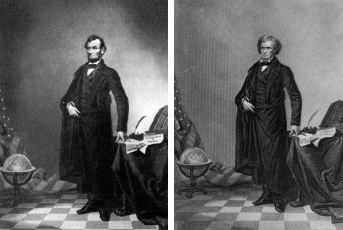A History of Faking Photographs
People started to manipulate photographs nearly as soon as the first camera produced the first photograph.
The famous portraiture of Abraham Lincoln standing with his hand on his desk is a fine example. In the 20th century it was discovered that his mole was on the opposite side of his face. A photo of Congressman John Calhoun of North Carolina was found, Calhoun was in the same pose. Someone had put Lincoln’s head on Calhoun’s body in the 1860’s; Photoshop wasn’t created for another 120 years or so. The Lincoln/Calhoun fake was distributed throughout the Union!

Because of the long exposure times required by the cameras during the Civil War, staging photographs was more popular than editing them. Due to the slow films many “action” shots were staged by the war photographers during the Civil war.
During the early 20th century there were photographic postcards that showed their subjects (fish, insects, and crops were often the subject) as being larger than life. The photographers did this by merging two pictures into a single image. Sort of a dark humor arose during the Dust Bowl years. The photographers would make the fruits and vegetable look huge. Presumable the irony was the joke.
The Soviet leader, Josef Stalin, famously edited out his comrades who “ceased to exist” after falling from favor. There are many examples people standing next to Stalin were simply painted over.
Modern magazine and newspapers fake their pictures too. During the OJ Simpson trials Time and Newsweek each used the police mug shot on their magazine’s cover. Time magazine chose to edit the image to make it look darker and more menacing than the original. Photojournalists have also been caught editing their images to make them more sensational, like adding smoke to a battlefield to make look more destructive than it really was… if it bleeds it leads.
Faking a photograph is more than just posing the subject in a scene. The motivation is to create visual lie designed to deceive the viewer.